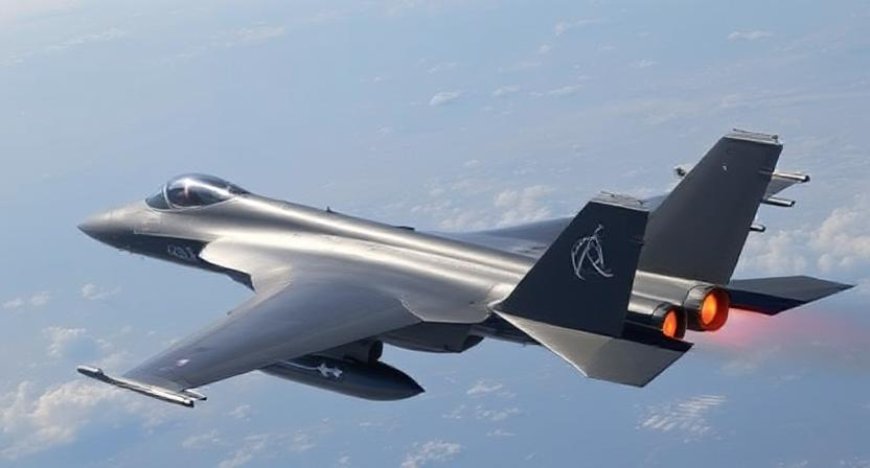The Rise of the F-47: Boeing’s Triumph in the Next-Generation Fighter Jet Race

In a groundbreaking development for the aerospace and defense industries, Boeing has secured a monumental contract to design and build the U.S. Air Force’s Next-Generation Air Dominance (NGAD) fighter jet, now officially designated as the F-47. This announcement, made on March 21, 2025, marks a pivotal moment not only for Boeing but also for the future of military aviation. The F-47 fighter jet, a 6th-generation marvel, promises to redefine air superiority, while simultaneously sending ripples through the stock markets and igniting fierce competition with rival Lockheed Martin. This article delves into the significance of the F-47, its impact on Boeing’s stock price, the technological advancements it represents, and the broader implications for the aerospace industry.
Boeing’s Big Win: The NGAD Announcement
The NGAD program, aimed at developing a family of systems to replace aging fighters like the F-22 Raptor, has been a coveted prize in the defense sector. On March 21, 2025, President Trump announced that Boeing had clinched the contract, a decision that has been met with both celebration and scrutiny. The F-47, as the new fighter jet will be called, represents the pinnacle of 6th-generation fighter technology, boasting advanced stealth capabilities, artificial intelligence integration, and unprecedented adaptability in combat scenarios.
The initial development phase of the F-47 is reportedly valued at $20 billion, with projections suggesting that the program could balloon to hundreds of billions over its multi-decade lifespan. This long-term investment underscores the strategic importance of the NGAD platform, which is designed to maintain U.S. air dominance in an era of escalating global tensions. Boeing’s Phantom Works division, known for its innovative approach to aerospace projects, spearheaded the effort, outmaneuvering competitors like Lockheed Martin, which had long been a dominant force in fighter jet production.
The F-47 Fighter Jet: A Technological Leap Forward
The F-47 plane is more than just a successor to previous fighter jets; it’s a leap into the future of warfare. As a 6th-generation fighter, it builds on the stealth and sensor fusion of 5th-generation aircraft like the F-35, while introducing cutting-edge features tailored for the battlefields of tomorrow. Though specific details remain classified, industry experts speculate that the F-47 jet will incorporate directed-energy weapons, hypersonic speed capabilities, and a modular design allowing for rapid upgrades. Its integration with unmanned drones and networked systems also hints at a revolutionary approach to air combat, where the fighter jet serves as a command hub rather than a standalone weapon.
Boeing’s success with the F-47 fighter jet is a testament to its ability to innovate under pressure. The company, which has faced challenges in its commercial aviation division in recent years, has leaned heavily on its defense arm to regain momentum. The F-47 plane not only strengthens Boeing’s portfolio of fighter jets but also positions it as a leader in the race for next-generation military technology.
Boeing Stock Soars: Market Reactions to the F-47 News
The NGAD announcement sent Boeing’s stock price soaring. In the days leading up to March 21, 2025, Boeing’s stock (BA) climbed from $143.51 to $180.55—a 25.8% increase—reflecting investor confidence in the company’s future. On the day of the announcement alone, shares rocketed up 9.6% to $183, fueled by the news of the F-47 contract. This surge brought Boeing tantalizingly close to its 52-week high, with trading volume spiking as the market absorbed the implications of the deal.
Analysts attribute this rally to the F-47’s potential to generate consistent revenue for decades. Unlike one-off contracts, the NGAD program promises sustained funding for development, production, and maintenance, providing Boeing with a financial lifeline. Moreover, the shift in contract negotiation practices—moving away from the costly “cost-plus” model to a fixed-cost structure—has been hailed as a taxpayer-friendly move that could further bolster Boeing’s profitability. Posts on X have celebrated this as a return to fiscal responsibility, with one user noting, “No more $10,000 hammers!”
Lockheed Martin’s Loss: A Shift in the Aerospace Landscape
The F-47 announcement wasn’t a win for everyone. Lockheed Martin, a titan in the fighter jet arena with its F-35 and F-22 programs, saw its stock (LMT) plummet nearly 7% following the news. The loss of the NGAD contract to Boeing has raised questions about Lockheed Martin’s future in 6th-generation fighter development. With no immediate sixth-gen fighter program in its pipeline—pending a potential protest of the decision—Lockheed Martin faces an uphill battle to reclaim its dominance.
This shift marks a significant departure from the status quo. Lockheed Martin has long been the go-to contractor for advanced fighter jets, but Boeing’s victory with the F-47 jet suggests a changing tide. Industry observers are now watching closely to see if Boeing can achieve a “clean sweep” by securing additional 6th-generation contracts, further sidelining its rival.
Boeing Fighter Jets: A Legacy Reinvigorated
Boeing’s history with fighter jets is storied but not without gaps. While the company has produced iconic aircraft like the F/A-18 Super Hornet, it has often played second fiddle to Lockheed Martin in the realm of cutting-edge fighters. The F-47 fighter jet changes that narrative, reinvigorating Boeing’s legacy in military aviation. The success of the F-47 plane could pave the way for Boeing to dominate the fighter jet market for years to come, leveraging its expertise in both manned and unmanned systems.
The F-47 Boeing fighter jet also arrives at a critical juncture for the company. After weathering scandals and setbacks in its commercial division, including the 737 MAX crisis, Boeing has been eager to prove its resilience. The NGAD contract offers a chance to do just that, showcasing the company’s ability to deliver on high-stakes, high-tech projects.
The Broader Implications: Boeing, NGAD, and the Future of Warfare
The F-47’s designation as part of the NGAD family signals more than just a new aircraft—it heralds a new era of warfare. The 6th-generation fighter concept emphasizes flexibility, connectivity, and resilience against emerging threats like cyber warfare and hypersonic missiles. For Boeing, the F-47 jet is an opportunity to shape this future, collaborating with the U.S. Air Force to create a platform that can evolve with the times.
Beyond the battlefield, the F-47 Boeing project has economic and political ramifications. The contract is expected to create thousands of jobs across the United States, bolstering Boeing’s manufacturing footprint. It also aligns with a broader push for American technological supremacy, a theme that resonates strongly in today’s geopolitical climate.
Challenges Ahead: Can Boeing Deliver?
Despite the excitement surrounding the F-47 fighter jet, challenges loom on the horizon. Boeing must navigate the complexities of developing a 6th-generation fighter on time and within budget—no small feat given the ambitious scope of the NGAD program. Past defense projects have been plagued by delays and cost overruns, and Boeing will face intense scrutiny to avoid similar pitfalls.
Moreover, Lockheed Martin’s potential protest of the contract award could introduce uncertainty. If successful, such a challenge might delay the F-47’s timeline or even reopen the bidding process. Boeing will need to maintain its momentum and prove that the F-47 plane is worth the investment.
Conclusion: The F-47 and Boeing’s Bright Future
The F-47 fighter jet represents a watershed moment for Boeing, the U.S. Air Force, and the aerospace industry at large. With its stock price surging, its rivalry with Lockheed Martin intensifying, and its reputation as an innovator restored, Boeing is riding high on the wings of the F-47 plane. As the NGAD program unfolds, the world will be watching to see if the F-47 Boeing fighter jet can live up to its promise as a game-changer in 6th-generation warfare.
For now, the announcement on March 21, 2025, stands as a triumph for Boeing—a signal that the company is not just back in the fight but poised to lead it. The F-47 jet fighter is more than a machine; it’s a symbol of ambition, resilience, and the relentless pursuit of excellence in the skies.





































